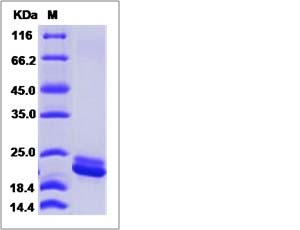Human IFNA4 Protein (His Tag)
IFN-alpha4a,INFA4,MGC142200
- 100ug (NPP3948) Please inquiry
| Catalog Number | P10336-H08Y |
|---|---|
| Organism Species | Human |
| Host | Yeast |
| Synonyms | IFN-alpha4a,INFA4,MGC142200 |
| Molecular Weight | The recombinant human IFNA4 consists of 176 amino acids and predicts a molecular mass of 20.8 kDa. |
| predicted N | Cys 24 |
| SDS-PAGE |  |
| Purity | > 95 % as determined by SDS-PAGE. |
| Protein Construction | A DNA sequence encoding the human IFNA4 (NP_066546.1) (Cys24-Asp189) was expressed with a polyhistidine tag at the C-terminus. |
| Bio-activity | Measured in antiviral assays using WISH cells infected with vesicular stomatitis virus. The ED50 for this effect is 2-10pg/mL. |
| Research Area | Immunology |Cytokines & Growth Factors |Cytokine & Receptor |Interferon & Receptor |Interferon |
| Formulation | Lyophilized from sterile PBS, pH 7.4. 1. Normally 5 % - 8 % trehalose, mannitol and 0.01% Tween80 are added as protectants before lyophilization. Specific concentrations are included in the hardcopy of COA. |
| Background | Interferon, alpha 4 (IFNA4) belongs to the alpha/beta interferon family. Two variants of IFNA4 (IFNA4a and IFNA4b) are known, which differ from each other by changes in their coding regions at nucleotide positions 220 and 410 and can be distinguished by selective restriction enzyme analysis. Interferons are produced by macrophages, IFN-alpha have antiviral activities. Interferon stimulates the production of two enzymes: a protein kinase and an oligoadenylate synthetase. IFN-alpha, the first cytokine to be produced by recombinant DNA technology, has emerged as an important regulator of growth and differentiation, affecting cellular communication and signal transduction pathways as well as immunological control. Originally discovered as an antiviral substance, the efficacy of IFN-alpha in malignant, viral, immunological, angiogenic, inflammatory, and fibrotic diseases suggests a spectrum of interrelated pathophysiologies. IFN-alpha emerged as a prototypic tumor suppressor protein that represses the clinical tumorigenic phenotype in some malignancies capable of differentiation. |
| Reference |
